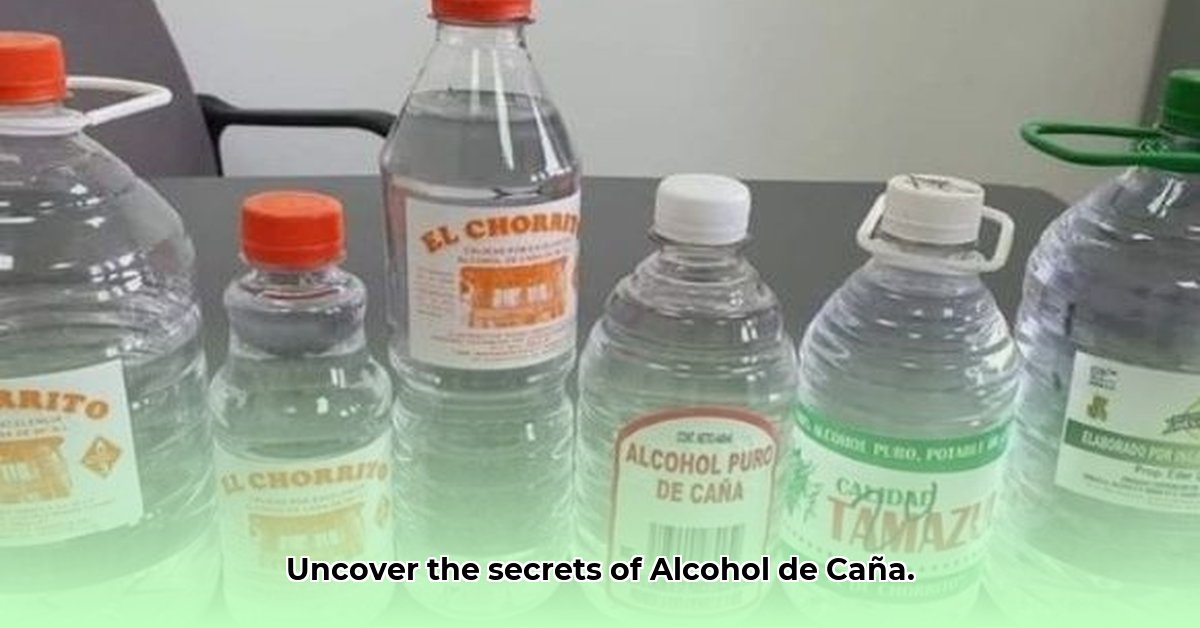Ever heard of alcohol de caña? It’s a spirit made from sugarcane, deeply rooted in Latin American culture with a rich history that varies from region to region. Like any alcoholic beverage, it’s important to understand its production, potential health risks, and regulations. This comprehensive article provides a complete picture, explaining the entire process from sugarcane field to glass, and guiding you on how to enjoy it safely and responsibly. Whether you’re a curious drinker, a culinary enthusiast, or an industry professional, this guide offers actionable insights into this multifaceted spirit.
Alcohol de Caña: A Deep Dive into This Versatile Spirit
Alcohol de caña, a spirit distilled from sugarcane juice, occupies a special place in Latin American culture, often intertwined with local traditions and celebrations. It’s a foundational spirit similar to cachaça (Brazil) and aguardente de cana (Portugal), and related to rum, though each possesses unique characteristics based on local production methods and sugarcane varieties. Its taste and strength vary widely depending on the production method, sugarcane source, and aging process, making it a truly unique spirit. Let’s explore its journey from sugarcane field to your glass and discuss sugarcane ethanol production.
From Sugarcane to Spirit: Revealing the Distillation Process
Making alcohol de caña is a fascinating process, often rich in age-old traditions that vary significantly across different regions and producers. Here’s a more detailed step-by-step breakdown of the distillation process:
- The Harvest: Farmers harvest ripe sugarcane, often by hand in many regions, preserving traditional methods passed down through generations. In some areas, mechanical harvesting is now used, but hand-harvesting is preferred for its selectivity. This careful harvesting ensures the cane is at peak ripeness, adding character to the final product. The sugarcane’s quality, including its sugar content and varietal, at this stage greatly influences the end result. Some producers even cultivate specific sugarcane varieties for their unique flavor contributions.
- Crushing Time: The sugarcane stalks get crushed to extract their sweet juice, known as guarapo. This process is akin to squeezing oranges for juice, but on a larger scale, utilizing multi-roller mills for maximum extraction. The efficiency of this crushing step directly optimizes juice yield, impacting the overall production volume and sugar concentration.
- Cleaning Up: The extracted juice undergoes clarification to remove impurities, such as soil, fiber, and other solids. Traditionally, this was done through settling and skimming. Modern methods involve filtration and the use of clarifying agents. This crucial step helps ensure the final product’s safety and taste, preventing off-flavors and cloudiness. Different clarification methods yield different flavor profiles, with some producers favoring traditional methods for their perceived contribution to the spirit’s character.
- Fermentation Frenzy: Yeast is added to the clean juice, converting natural sugars into alcohol. Wild yeasts are sometimes used in traditional production, while commercial yeasts offer more consistent results. The fermentation time, temperature, and yeast strain influence the final flavor profile, creating a wide array of aromas and tastes. This stage is critical in developing the unique characteristics of alcohol de caña. Some producers even employ multiple fermentation stages to achieve desired complexities.
- Distillation Delight: This key step separates the alcohol from the water and other elements in the juice, concentrating the alcohol for a stronger drink. Pot stills and column stills are both employed, with each imparting distinct characteristics. Different distillation techniques result in different alcohol de caña styles, some smoother, some bolder. Skilled distillers carefully monitor temperature and cut points to isolate the desired flavor compounds.
- Optional Aging: Producers may age some alcohol de caña in oak barrels, similar to fine wines or whiskeys. Different types of oak, char levels, and previous contents of the barrels (e.g., sherry, bourbon) all contribute to the final flavor profile. This aging process imparts flavors like vanilla, caramel, and spices, making the spirit more complex and mellow. The aging duration and barrel type dramatically affect the final taste and aroma, transforming the raw spirit into a nuanced and sophisticated product. Some producers also experiment with aging in other types of wood.
- Blending and Bottling: Some producers blend different batches or ages of alcohol de caña to achieve a consistent flavor profile. The spirit is then filtered and bottled, ready for distribution and enjoyment.
These variations in the process, from sugarcane variety and yeast type to distillation methods and aging techniques, explain the vast differences in alcohol de caña types worldwide.
More Than Just a Drink: The Cultural Heart of Alcohol de Caña
Alcohol de caña has been a vital part of the cultural fabric of many Latin American countries for generations, deeply intertwined with local customs and social gatherings. It’s a key ingredient in traditional recipes, from simple cooking to festive cocktails, lending a distinct flavor and cultural significance. It’s a staple at celebrations, reflecting communities’ history and shared experiences, often playing a central role in rituals and festivities. Its economic impact is also significant, supporting many jobs and businesses within local communities, from sugarcane farmers to distillers and distributors. In many regions, the production of alcohol de caña is a source of pride and a symbol of local identity.
The Ups and Downs: Understanding the Risks
Like any alcoholic beverage, alcohol de caña poses health risks, especially with irresponsible consumption. Some versions have a high alcohol content (ABV), increasing the chances of alcohol abuse or dependence. The strength can also vary significantly, making it difficult to gauge the level of intoxication. Moderate consumption of alcohol de caña, or any alcohol, is crucial. Unregulated production can lead to inconsistent quality and even unsafe products, containing harmful impurities or excessive levels of methanol. Acetaldehyde, a toxic substance that your body produces when processing alcohol, is a concern regardless of the alcoholic beverage type. Responsible consumption, clear labeling, and purchasing from reputable sources are essential.
Regulations, Responsibilities, and the Road Ahead
The production and sale of alcohol de caña faces regulatory challenges, particularly in balancing traditional methods with safety and quality control. Regulations vary widely from country to country, and even within different regions of the same country. A lack of standardization can lead to inconsistent quality and ABV, making it difficult to know the exact alcohol content and assess the potential risks. Purchase from trusted producers, checking for clear labels with alcohol content and ingredient information, to make informed choices and practice responsible drinking. Look for certifications or seals of approval that indicate the product has met certain quality standards.
For the future, governments, producers, researchers, and consumers need to collaborate to ensure the sustainable and responsible production and consumption of alcohol de caña. Stricter regulations, transparent labeling, and campaigns promoting responsible drinking are essential. Supporting small-scale, traditional producers while ensuring product safety is a key challenge. Further research comparing alcohol de caña to other alcoholic drinks is needed to better understand its health effects and inform future policies. This research should also focus on the potential impact of different production methods and sugarcane varieties on the spirit’s composition and health effects.
A Quick Look at the Risks: A Risk Assessment Matrix
| Factor | Likelihood of Risk | Severity of Risk | Ways to Reduce Risk |
|---|---|---|---|
| Unregulated Production | High | High | Stronger regulations and market checks are needed. Support certified producers. |
| Misleading Labeling | Medium | Medium | Clearer labeling rules and better consumer education. Standardize labeling requirements. |
| High ABV Products | High | High | Clear ABV labels and responsible drinking campaigns. Promote lower-ABV alternatives. |
| Lack of Consumer Awareness | Medium | Medium | Public health campaigns educating about responsible use. Highlight the risks of excessive consumption. |
Alcohol de caña’s story consists of a rich tradition, complex production, and ongoing regulatory challenges. The responsible enjoyment of this spirit depends on informed consumers making smart choices, supporting sustainable practices, and advocating for clear and transparent regulations.
How to compare the health risks of cane alcohol to other spirits
Key Takeaways:
- Cane alcohol contains ethanol, like other spirits. The health risks associated with cane alcohol are essentially the same as other alcoholic beverages. Consume in moderation, regardless of the source of ethanol.
- Any purported health benefits from sugarcane itself are insignificant compared to the risks of ethanol. Don’t be misled by marketing claims suggesting health benefits.
- Organic certification doesn’t negate the risks of alcohol consumption. Organic simply means the sugarcane was grown without synthetic pesticides, it does not change the ethanol’s impact.
- Variations in alcohol by volume (ABV) across different cane alcohol products necessitate careful consideration of safe consumption levels. Always check the ABV and adjust your consumption accordingly.
Understanding Alcohol de Caña: From Sugarcane to Spirit
Alcohol de caña, including spirits like rum and cachaça, starts with sugarcane. Sugarcane juice or molasses undergoes fermentation, converting sugars into ethanol (a type of alcohol). Distillation concentrates the ethanol, resulting in the final product. The fermentation processes are similar to other spirits’ production that uses grains, fruits, or other sugars as their base. The key difference lies in the starting material and flavor profile, not the ethanol itself. Production methods can also influence the presence of congeners, which can contribute to hangovers.
How to compare the health risks of cane alcohol to other spirits: A Direct Comparison
The main health risk of alcoholic beverages comes from ethanol. This applies to rum, vodka, whiskey, tequila, and alcohol de caña. It doesn’t matter if the alcohol source is sugarcane or barley; ethanol
- Plant Based Diet Breast Cancer: Research-Based Benefits - December 16, 2025
- Plant-Based Diet Ulcerative Colitis Remission: Proven Benefits - December 15, 2025
- Plant-Based Diet and Fibroids: Reduce Symptoms Now - December 13, 2025










